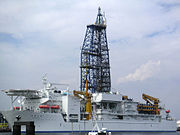Integrated Ocean Drilling Program
 |
| Deep-sea Drilling Vessel "CHIKYU" |
The Integrated Ocean Drilling Program (IODP) is an international marine research drilling program dedicated to advancing scientific understanding of the Earth by monitoring and sampling subseafloor environments. Through multiple platforms—a feature unique to IODP— the world’s preeminent scientists explore the deep biosphere and subseafloor; environmental change; Earth processes and effects; and solid earth cycles and geodynamics; principal program themes.
IODP: Investigating Earth, Oceans, and Life
The Integrated Ocean Drilling Program (IODP) brings together hundreds of scientists from dozens of countries and scientific disciplines to conduct cutting-edge investigations of Earth deep below the seafloor. For each drilling project undertaken, IODP employs the best-suited drilling platform available along with complementary drilling tools and technologies. IODP affords scientists the opportunity to:
1. recover geological records and rock samples.
2. investigate and document ocean and climate change through time.
3. explore the presence of primitive life below the seafloor.
4. verify remote, near-seafloor observatories.
5. gain understanding of how tectonic plates move and recycle themselves into Earth’s deep mantle.
Focus on Earth
IODP scientists pursue new knowledge about Earth’s past to meet today’s global challenges. Two previous scientific ocean drilling programs generated abundant information about Earth’s dynamic nature: tectonic processes, ocean circulation, climate change, continental rifting, and ocean basin formation. Today, scientific ocean drilling continues to provide a powerful tool to study the critical processes related to Earth’s short-term change and long-term variability. IODP expands the scope of ocean drilling investigations, and pushes the limits of technology by providing diversedrilling platforms to meet specific requirements of each planned drilling project.
IODP focuses on ocean basins—rich archives and ideal natural laboratories—to study the interdependence of physical, chemical, and biologicalprocesses. IODP research also centers on those factors that control climate change, the vast circulation of fluids within Earth’s crust,the nature of life on and within Earth, and the dynamics of lithospheric formation and recycling.
IODP was conceived as a 10-year Earth science and research program that started in 2003. Its prescribed drilling activities require weeks,sometimes months of drilling at a single location, a variety of drilling hardware, new engineering strategies to ensure pristine samples,and ventures into harsh and demanding environments. Despite the achievements made during the past 40+ years ofocean drilling activity, IODP continues to pioneer research in “inner space,” investigating expansive, deep subseafloor environments that retain their scientific intrigue well into the 21st century.
Navigating the Route to Discovery
Scientific ocean drilling represents Earth science’s longest running and most successful international collaboration. In 1961 when drilling technology was used to successfully recover the first sample of oceanic crust, scientific drilling took root as a new scientific technique. Aboard the CUSS 1, a modified U.S. Navy barge and one of the earliest scientific drilling expeditions, American author John Steinbeck, also an amateur oceanographer, documented the historic Project Mohole for LIFE Magazine. Over the next 45 years, scientific ocean drilling revolutionized Earth science, as it continues to do today.
Legacy Programs
The Deep Sea Drilling Project (DSDP), established in June 1966, operated the Glomar Challenger in drilling and coring
operations in the Atlantic, Pacific, and Indian Oceans, as well as in the Mediterranean and Red Seas. The Challenger’s{| align="right" class="wikitable" border="1"
|-
! header 1 Deep Ocean Explorer: Glomar Challenger
|-
| row 1, cell 1
| row 1, cell 2
| row 1, cell 3
|-
| row 2, cell 1
| row 2, cell 2
| row 2, cell 3
|}
success occurred nearly immediately: Its coring operations enabled DSDP to provide the next intellectual step in
verifying the hopothesis of plate tectonics associated with seafloor spreading, by dating basal sediments on transects
away from the Mid-Atlantic Ridge. The Challenger also advanced the technology of deep-ocean
drilling. In June 1970, for example, DSDP engineers devised a way to replace worn drill bits and then re-enter boreholes
for deeper drilling. This formidable task was mastered in the Atlantic Ocean off the coast of New York, in 10,000 feet
(3,048 meters) of water. The feat required the use of sonar scanning equipment and a large-scale re-entry cone.
Participating organizations include: ODP Management International, Inc., Joint Oceanographic Institutions, Inc., Lamont-Doherty Earth Observatory of Columbia University, Texas A&M University, and Texas A&M Research Foundation.
References
External links

